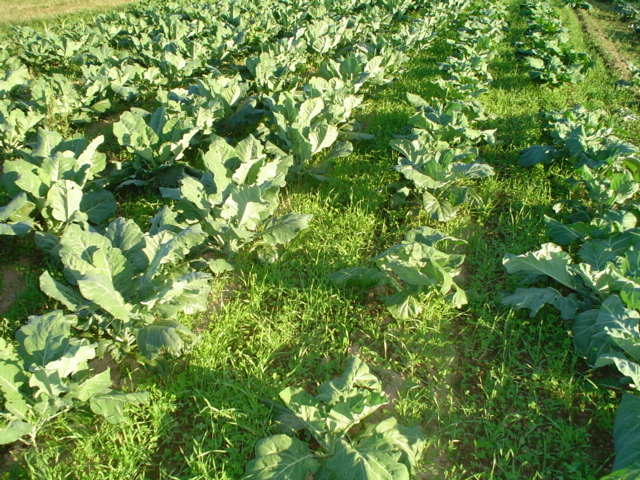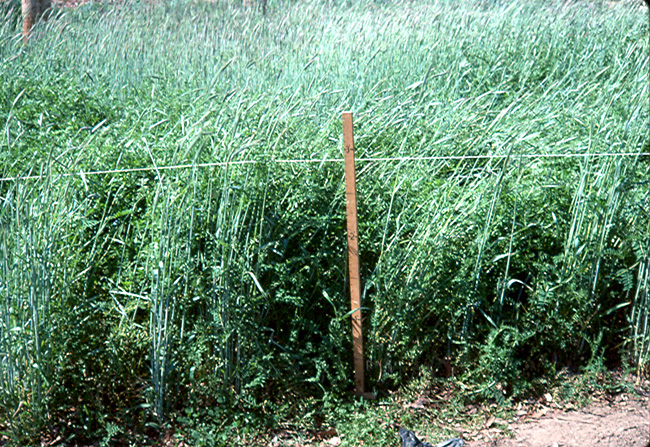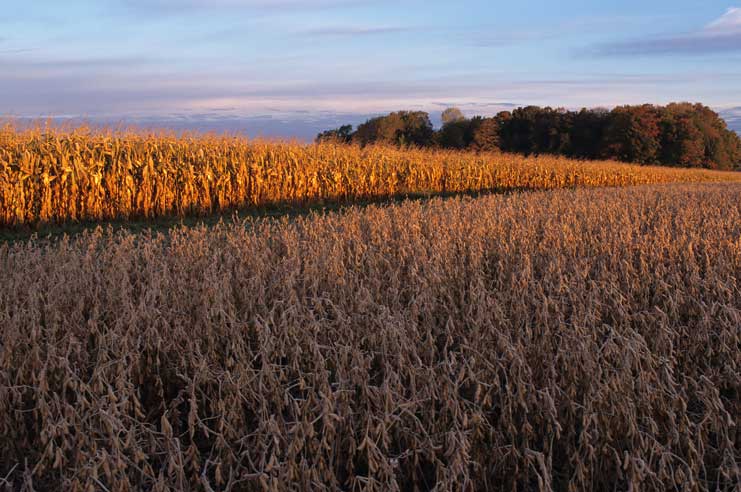The Blogging Farmer
Alex Tiller’s Blog on Agriculture and Farming
Farmers Try Cover Crops to Protect Their Product
A field of cover crops: in between the collards in this field is a cover crop mix of rye, hairy vetch and crimson clover, which provides a lush cover protecting the soil from harsh winds and eroding/compacting rains.Efficient farming can be practiced in many ways, but one method that has become more popular in recent years is the use of cover crops. The quality of the soil has a direct impact on the health of the farm and its output, so crops that boost soil quality rather than degrading it actually add to the value of the land they are grown on. There are various kinds of cover crops that have different ecological impacts on the land, but the general idea is that rain water is held in the soil by the plants, and nitrogen from lower soil layers is drawn higher up in the soil. This way, the next crop, such as corn, can make better use of nutrients. Peas and soybeans have traditionally been used for cover crop purposes, but Minnesota farmer Dean Schuette took part in a trial using tillage radish as a cover crop in November 2011. The goal is to see if this increases the corn yield in 2012, but early results from the mix of radish and an oat-pea mix have already yielded radishes that are larger than normal.
Researchers say that deep-rooted cover crops work best in drawing up the nitrogen, as do mustard crops. The effectiveness of using a cover crop is dependent on the species of crop; different plants grow roots at different speeds and which extend to different depths. Planting dates matter too, because most plant roots will grow longer over time. This is crucial in selecting the type of plant depending on the type of winter expected for a certain region. Even if plants die the nitrogen can still be left at higher level in the soil for the next crop. Oats and oilseed radish usually leak their nitrogen storage quicker than other plants so that it is there when the next crop is established. With other cover crops, such as rye, the timing of nitrogen release can be unpredictable.
A cover crop biculture of grass–legume can compete more effectively against weeds than either component alone. In this mature winter cover crop, the cereal rye has permeated the topsoil with a dense fibrous root system and provided support for the hairy vetch, allowing the latter to grow more vigorously and cast dense shade on the soil surface. Very little weed biomass was found in this cover crop, photographed here in late May 2011 on Cape Cod, MA. (Photo: Mark Schonbeck, Virginia Association for Biological Farming.)In Iowa, a trial using rye cover crops has been taking place for the last couple of years. Farmer Arliss Nielson planted hairy vetch and sweet clover, both along with winter rye, over 350 acres. The rye was seeded into the corn crop by airplane in September 2010, and the corn stalks the following season seemed to be more protected, even though the vetch and clover didn't survive the winter. Nielson plans to continue participation in the project, while other farmers have considered being involved as part of a cost-sharing program called the Boone River Watershed Mississippi River Basin Initiative.
Cold temperatures eventually kill many cover crops. Radish, for example, often dies off in late fall, but rye can capture some of the nitrogen released by the plant matter. Combinations of cover crops, therefore, have been seen as beneficial. Other projects, such as one in Ontario, Canada, used cover crops and manure following a wheat harvest in 2003. Cover crops were planted after an early harvest of a vegetable crop; both studies are just a couple of examples of how farmers have looked at cover crops and continue to do so. The effectiveness of various methods is still being studied to find the most effective ways to protect main crops as well as make them more lucrative.
(Posted at Alex Tiller’s Blog on Agriculture and Farming, January 11, 2012)Sources:
AgriNews***
Low Interest Rates Keep Farmland Prices High
Depending on which side of the table they are on, farmers will talk differently about U.S. agricultural policy. Those that see profit argue for subsidies and the volatile market for crops and commodities. Others struggle to make ends meet and advocate change in the subsidy structure and the market that encourages overproduction. For investors, times have never been better for buying up farmland, with interest rates at historic lows. Land values are now increasing at up to 8% per year, while commodity prices being as high as they are making investing in farmland very lucrative. All of this in a time where economic troubles persist and when traditional investments, particularly money market investments on Wall Street, are considered too risky.
Crops are also attributing to the situation. The high prices of corn and soybean are yielding support for investors because they raise the value of the land, and are expected to do so into 2012. Department of Agriculture experts see no reason why this won't hold up. Economist Scott Stiles with the University of Arkansas Division of Agriculture said high commodity prices along with low interest rates for loans, real estate, and equipment are favorable for investors. The demand for crude oil in farm operations is not much of a concern, since prices have dropped with economic woes, although daily supplies like seed and fertilizer remain high in cost along with soybeans and corn.
Corn and soybean crops on the Michigan State University campus. The high prices of corn and soybean are yielding support for investors because they raise the value of the land. (Photo: Karl Stepnitz)Like other markets that have sustained a boom for periods of time, like the housing market, other experts worry that the farmland market could go bust at some point. The housing bubble burst and wrecked havoc on the real estate market. At the same time, low mortgage rates are helping investors as they buy up farmland. Borrowing costs have helped as well, with an average rate of 5.8% on variable-rate mortgage loans for farmland between April and June 2011. Heartland rates were the lowest, while mortgage rates were higher in areas affected by drought like Oklahoma and Texas. Reasonable rates across the board have allowed more buyers to seek out farmland as the situation has been favorable for more investors to afford it.
With a volatile economic market in play, investors have caught on quickly and have bought up a significant portion of Midwest farmland, which could prove valuable as they cash in down the road. While other markets recover from the recession, agriculture remains a place to put their money in, but how long the bubble continues to expand is anyone's guess. The low interest rates and high land prices favor investment deals. Another bubble burst in the future is uncertain, but hopefully by then the housing market, equity markets and other targets of investment will be lucrative once again. For now, many investors continue to keep their eye on the farm and are doing quite well this way.
(Posted at Alex Tiller’s Blog on Agriculture and Farming, December 29, 2011)
Sources:
Delta Farm Press
Hello, and thanks for checking out my blog. My name is Alex Tiller and I grew up in rural Ohio (Clark County) where my family still owns farmland (corn and beans). I am a member of the American Society of Farm Managers and Rural Appraisers and am also an agribusiness author/blogger. I write about commercial farming, family farms, organic food production, sustainable agriculture, the local food movement, alternative renewable energy, hydroponics, agribusiness, farm entrepreneurship, and farm economics and farm policy. I visit lots of farms in different areas of the country (sometimes the world) that grow all kinds of different crops and share what I learn with you through this blog.? You can contact me via email by clicking here: Email Alex at http://blog.alextiller.com/contact
Founder/Publisher/Editor: David McGee
Contributing Editors: Billy Altman, Laura Fissinger, Christopher Hill, Derk Richardson
Logo Design: John Mendelsohn (www.johnmendelsohn.com)
Website Design: Kieran McGee (www.kieranmcgee.com)
Staff Photographers: Audrey Harrod (Louisville, KY; www.flickr.com/audreyharrod), Alicia Zappier (New York)
E-mail: thebluegrassspecial@gmail.com
Mailing Address: David McGee, 201 W. 85 St.—5B, New York, NY 10024





